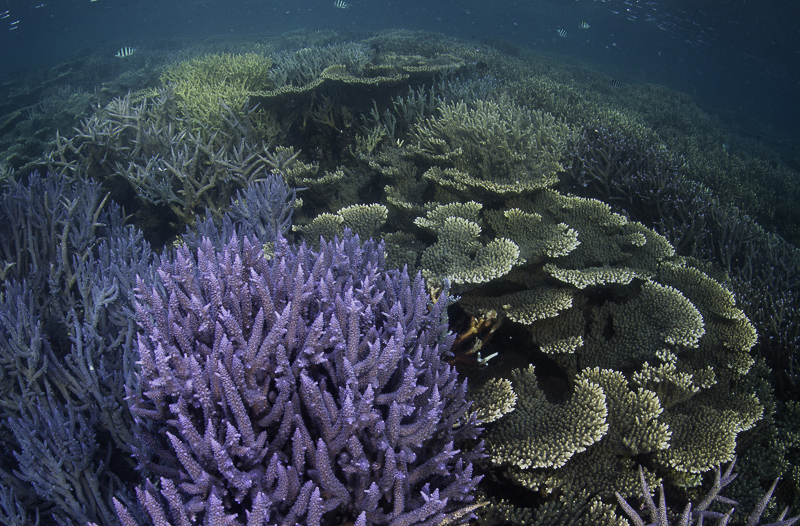
More than meets the eye: corals on the Great Barrier Reef are about to undergo radical revision of species classifications. Image: Tom Bridge.
Scientists are using a new genetic tool to identify corals—with astonishing results
via ARC Centre of Excellence for Coral Reef Studies
“The traditional classification of corals is dead,” says Prof Andrew Baird, from James Cook University, who led a recent scientific journey along the Great Barrier Reef, uncovering “treasure troves” of new, unidentified coral species.
“New molecular tools allow us to reinvent a new classification system on the ashes of the old. Hence, the name we have given to the research: Project Phoenix,” he said.
“These are exciting times to be a coral taxonomist.”
The new laboratory tools causing all the excitement and upheaval are described in a recent journal paper whose abstract begins: “Targeted enrichment of genomic DNA can profoundly increase the phylogenetic resolution of clades and inform taxonomy. Here, we redesign a custom bait set previously developed for the cnidarian class Anthozoa to more efficiently target and capture ultraconserved elements (UCEs) and exonic loci within the subclass Hexacorallia.”
What this means, essentially, is that new methods of DNA testing can target regions of the coral genome that are relevant to the specific research interests, allowing scientists to zero in on novel variants and better differentiate species. Many current coral “species” are predicted to turn into multiple true species, linked by their actual DNA profiles rather than physical appearance. Aquarists, divers, marine biologists: Be ready to have all your existing reference works on stony coral genera and species become obsolete.
Dr. Andrea Quattrini, curator of corals at the Smithsonian Institution’s National Museum of Natural History, developed the new genetic tool. She says it provides a way forward with plans to secure the future of coral reefs.
“By comparing thousands of key genetic coral features, we were able to discern the evolutionary relationships of corals from the Great Barrier Reef and broader Indo-Pacific region,” Dr. Quattrini says.
“The result is a new classification that provides important scientific knowledge to assess the various intervention strategies currently being proposed on the Great Barrier Reef and elsewhere.”
“Surprisingly, we still don’t know how many coral species live on the Great Barrier Reef, how to identify them, or which species live where. And those are the first steps in saving an ecosystem like that,” says Dr. Peter Cowman from the ARC Centre of Excellence for Coral Reef Studies at James Cook University (Coral CoE at JCU).
Dr. Cowman led an international study on coral classification to explain how species are related to each other. In classic morphologically-driven taxonomy, shared physical similarities and differences provide a key to help identify species. For example, dogs and cats are classified on different branches of the evolutionary tree using their body design.
A seemingly finer detail, like how cats can retract their claws and dogs cannot, helps people decide whether a newly discovered species of small carnivore is more like a dog or a cat.
Dr. Cowman says an important challenge when identifying corals is that the same species can grow in many different ways.
“For instance, some species can grow with either a plate or branch structure. The study found classifying corals by their physical characteristics didn’t match the classifications based on their genetics,” he says.
Species identification underpins almost all biological and ecological research, and the new study challenges more than 200 years of coral classification. The researchers say the traditional method does not accurately capture the differences between species or their evolutionary relationships.
“We need to review the way we currently identify corals,” says CORAL author Dr. Tom Bridge from Coral CoE at JCU, who is also the curator of corals at the Queensland Museum. (See his video below.)
Dr. Bridge says research in the past ten to 20 years has already revolutionized the understanding of the older branches on the evolutionary tree of corals. But, to date, there has been little progress on the more recent twigs of the “tree”—the living species—particularly with the most diverse and ecologically-important group: the Acropora.
“The Acropora are the branching ‘staghorn’ corals that dominate reefs,” Dr. Bridge says. “Yet, even in well-researched locations like the Great Barrier Reef, we can’t identify many of these species accurately.”
Dr. Cowman says the traditional method doesn’t reflect the tens of millions of years of coral evolution.
“At the moment, we’re flying blind,” he says.
Some of the interventions being proposed on the reef in an effort to preserve coral biodiversity in the face of warming ocean temperatures include hybridizing species and relocating some populations to the south.
“It’s clear we do not know enough about many of the species we’re dealing with. This new method can help generate the robust science we need to assess such proposals,” Dr. Bridge says.
References
From materials released by ARC Centre of Excellence for Coral Reef Studies, 15 SEP 2020.
https://www.coralcoe.org.au/media-releases/project-phoenix-dna-unlocks-a-new-understanding-of-coral
Cowman P, Quattrini A, Bridge T, Watkins-Colwell G, Fadli N, Grinblat M, Roberts E, McFadden C, Miller D, Baird A. (2020). ‘An enhanced target-enrichment bait set for Hexacorallia provides phylogenomic resolution of the staghorn corals (Acroporidae) and close relatives’. Molecular Phylogenetics and Evolution. DOI: 10.1016/j.ympev.2020.106944
Abstract
Targeted enrichment of genomic DNA can profoundly increase the phylogenetic resolution of clades and inform taxonomy. Here, we redesign a custom bait set previously developed for the cnidarian class Anthozoa to more efficiently target and capture ultraconserved elements (UCEs) and exonic loci within the subclass Hexacorallia. We test this enhanced bait set (targeting 2476 loci) on 99 specimens of scleractinian corals spanning both the “complex” (Acroporidae, Agariciidae) and “robust” (Fungiidae) clades. Focused sampling in the staghorn corals (genus Acropora) highlights the ability of sequence capture to inform the taxonomy of a clade previously deficient in molecular resolution. A mean of 1850 (±298) loci were captured per taxon (955 UCEs, 894 exons), and a 75% complete concatenated alignment of 96 samples included 1792 loci (991 UCE, 801 exons) and ~1.87 million base pairs. Maximum likelihood and Bayesian analyses recovered robust molecular relationships and revealed that species-level relationships within the Acropora are incongruent with traditional morphological groupings. Both UCE and exon datasets delineated six well-supported clades within Acropora. The enhanced bait set will facilitate investigations of the evolutionary history of many important groups of reef corals, particularly where previous molecular marker development has been unsuccessful.





